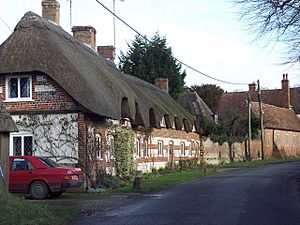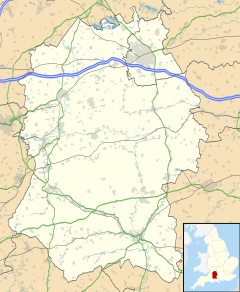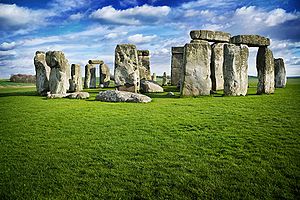Amesbury facts for kids
Quick facts for kids Amesbury |
|
|---|---|
 Cottages in Amesbury |
|
| Population | 12,995 (2021 Census) |
| OS grid reference | SU1642 |
| Civil parish |
|
| Unitary authority |
|
| Ceremonial county | |
| Region | |
| Country | England |
| Sovereign state | United Kingdom |
| Post town | SALISBURY |
| Postcode district | SP4 |
| Dialling code | 01980 |
| Police | Wiltshire |
| Fire | Wiltshire |
| Ambulance | Great Western |
| EU Parliament | South West England |
| UK Parliament |
|
Amesbury is a town and civil parish in Wiltshire, England. It is famous for the ancient monument of Stonehenge, which is very close by. People believe Amesbury is the oldest place in Great Britain where people have lived continuously. It was first settled around 8820 BC! The area also includes small villages like Ratfyn and West Amesbury, plus part of a military airfield called Boscombe Down.
Contents
What Does the Name Amesbury Mean?
The exact meaning of the name Amesbury isn't fully known. It might come from an old Anglo-Saxon name, Ambre. Another idea is that it comes from the Old English words amore-burh. This means 'fortification frequented by buntings or yellowhammers' (types of birds). Some people also think the name comes from Ambrosius Aurelianus. He was a leader who fought against Saxon invaders in the 400s.
Where is Amesbury Located?
Amesbury is in southern Wiltshire, about 7 miles (11 km) north of Salisbury. It sits in the River Avon valley, on the edge of Salisbury Plain. For a long time, Amesbury has been an important place to cross the river. This was especially true for the road connecting London to Warminster and Exeter. Today, the A303 road crosses the Avon right next to the town. The town first grew around the water meadows by the river. Over time, it has spread onto the hillsides and now includes part of the military airfield at Boscombe Down.
Amesbury's History
Ancient Times and the Middle Ages
People have lived around Amesbury since prehistory, long before written records. The famous Stonehenge monument is proof of this. In 2014, archaeologists found that Amesbury has been lived in non-stop since 8,820 BC. This led a newspaper to say that Amesbury was "where British history began."
Other discoveries in the area show that there were large ancient structures and settlements. These include Bluestonehenge and many other monuments near Stonehenge. A Neolithic village was also found nearby. In 2002 and 2003, archaeologists found the Amesbury Archer and the Boscombe Bowmen. These were important ancient burials.
During the Iron Age, a large hill fort called Vespasian's Camp was built. It was next to the Stonehenge Avenue and looked over the River Avon. This fort could have held up to 1,000 people. It was probably surrounded by smaller villages and farms.
There isn't much information about Roman times in Amesbury. However, Roman buildings have been found near Stonehenge. A large Roman graveyard was also found where the Amesbury Archer was buried. It's likely that a big Roman settlement was located here, overlooking the River Avon.
It's possible that monks had a monastery here. It might have been destroyed by the Saxons before they settled the area in the 600s. King Alfred mentioned Amesbury in his will, leaving it to his youngest son, Aethelweard. In 1086, the Domesday Book recorded Amesbury as a settlement with 111 households and eight mills.
In 979 AD, a Benedictine abbey was founded in Amesbury. It was called the Abbey of St Mary and St Melor. In 1177, King Henry II closed the abbey. He replaced it with Amesbury Priory, which had nuns and monks. King Henry III visited the priory many times. His wife, Eleanor of Provence, retired there in 1286. This led to visits from her son, King Edward I. The priory continued until 1540, when it was closed down. Its buildings were then pulled down.
Amesbury is also linked to the Arthurian legends. It was said that Queen Guinevere retired to a convent in Amesbury. This story first appeared in a Middle English romance text around 1350-1400. It was later repeated in Sir Thomas Malory's Le_Morte_d'Arthur. In 1542, a historian named John Leland said that Guinevere was buried in Amesbury. He claimed she was later moved to Glastonbury Abbey to be with King Arthur. In the early 1600s, an old noblewoman's grave was found at the old Abbey site. Many people believed it was Guinevere's grave. Visitors came to Amesbury to see it, and a plaque was supposedly put up.
Modern History
On an old map from 1611, Amesbury was spelled both Amesbury and Ambersbury.
After the abbey closed, Amesbury became a private estate. It was given to Edward Seymour by the King. A new large house, called Amesbury Abbey, was finished in 1661. It was designed in a classical style.
The estate later belonged to different families. In the early 1800s, it's thought that the Duke of Queensberry planted the Nile Clumps of trees. He did this to remember Admiral Nelson. He also had the hillfort landscaped as part of the mansion's grounds.
In 1824, Sir Edmund Antrobus bought the estate. The mansion was in bad shape, so he had it rebuilt between 1834 and 1840. In 1915, Lord Antrobus sold the land, including Stonehenge, to private buyers. However, the mansion stayed with the Antrobus family until 1979. Today, the house is a nursing home.
In 1677, John Rose started two schools in Amesbury. One was a grammar school for 20 local children. The other was an "English school" for poor children. The grammar school closed in 1899, and the children went to a different school.
Recent History
Amesbury started to grow more when the military airfield at Boscombe Down was set up in 1939. Because it's near the A303 road, Amesbury has seen many new housing developments. The newest one, Archers Gate, is named after the Amesbury Archer discovery. A business park called Solstice Park has also been built near the A303 junction.
In 2018, an incident occurred where two people became unwell at a property in Amesbury. One person later died. As a result, it was reported in 2020 that the Amesbury property would be taken down.
Population of Amesbury
In 2011, the civil parish of Amesbury had a population of 10,724 people. The wider Amesbury Community Area, which includes many surrounding villages, had an estimated population of 33,660 in mid-2011.
How Amesbury is Governed
The civil parish of Amesbury has a town council that local people elect. The area is part of Wiltshire Council, which is in charge of most local government services. For national elections, Amesbury is part of the East Wiltshire voting area.
Transport in Amesbury
Amesbury is about 6 miles (10 km) from the nearest train station, Grateley. This station is on the main train line from London to Salisbury. Amesbury's own train station closed in 1963.
Amesbury Bus Station closed in 2014. However, local bus services still stop in the town. There are frequent bus services connecting Amesbury to Salisbury, Tidworth, and Andover. National Express also provides a bus service to London. Other bus routes connect Amesbury to Larkhill and Swindon.
Local Media
Local TV news for Amesbury comes from BBC West and ITV West Country. You can also sometimes get BBC South and ITV Meridian. For radio, Amesbury has BBC Radio Wiltshire and Greatest Hits Radio Salisbury. There's also British Forces Broadcasting Service for military personnel nearby. The local newspapers are the Salisbury Journal and the Avon Advertiser.
Religious Sites
The main church in Amesbury is the Church of St Mary and St Melor. It is a very old building, with parts from the early 1100s and much of the rest from the 1200s. Its large size might be because of Amesbury's early royal connections or its link to the old Amesbury Abbey.
Amesbury Methodist Church was built in 1900. Christ the King Catholic church opened in 1985. Amesbury Baptist Church was built in 1997.
Notable Buildings
The large house known as Amesbury Abbey is a very important historical building. It stands in a park near where the old abbey used to be. It was built between 1834 and 1840. Before that, a similar house was built in 1661. The park grounds include a beautiful ornamental bridge. Today, the house is a nursing home. Diana's House and Kent House are old gatehouses to the property from the early 1600s. They have an unusual design.
The Red House on Salisbury Road is a former farmhouse. It was rebuilt around 1700 with red bricks. It's considered one of the best older houses in the area. It has a pretty porch from the early 1800s. Nearby, Antrobus House was built in 1924–1925. It was a memorial to Lady Florence Antrobus's son, who died in war. It was meant to be a village hall and is built to a very high standard.
West Amesbury House dates from the 1400s. It was updated in the early 1900s.
Education in Amesbury
Amesbury has one secondary school, The Stonehenge School. It also has four primary schools:
- Amesbury Archer Primary School
- Amesbury Church of England Voluntary Controlled Primary School
- Christ The King Catholic Primary School
- King's Gate Primary School
Amenities and Activities
Amesbury town centre has a hotel and restaurant called the Antrobus Arms. There are also four pubs: The George Hotel, The Kings Arms, The New Inn, and The Bell. These are places where people can eat, drink, and meet.
Antrobus House is a place used for community groups, weddings, and other events.
Amesbury has a football club called Amesbury Town F.C., which plays at Bonnymead Park. The Amesbury Bowls Club has its green and clubhouse at Antrobus House.
See also
 In Spanish: Amesbury para niños
In Spanish: Amesbury para niños




